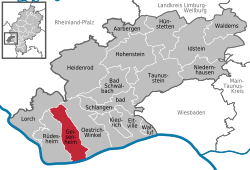Geisenheim
| Geisenheim | ||
|---|---|---|
|
||
| Coordinates: 49°59′4″N 7°58′2″E / 49.98444°N 7.96722°ECoordinates: 49°59′4″N 7°58′2″E / 49.98444°N 7.96722°E | ||
| Country | Germany | |
| State | Hesse | |
| Admin. region | Darmstadt | |
| District | Rheingau-Taunus-Kreis | |
| Government | ||
| • Mayor | Frank Kilian | |
| Area | ||
| • Total | 40.34 km2 (15.58 sq mi) | |
| Population (2015-12-31) | ||
| • Total | 11,690 | |
| • Density | 290/km2 (750/sq mi) | |
| Time zone | CET/CEST (UTC+1/+2) | |
| Postal codes | 65366 | |
| Dialling codes | 06722 | |
| Vehicle registration | RÜD, SWA | |
| Website | www.geisenheim.de | |
Geisenheim is a town in the Rheingau-Taunus-Kreis in the Regierungsbezirk of Darmstadt in Hessen, Germany, and is known as Weinstadt (“Wine Town”), Schulstadt (“School Town”), Domstadt (“Cathedral Town”) and Lindenstadt (“Linden Tree Town”).
Geisenheim lies on the Rhine’s right bank between Wiesbaden and Rüdesheim, 3 km away to the west. Mainz lies 21 km away to the east.
Geisenheim borders in the north on the town of Lorch, in the east on the town of Oestrich-Winkel, in the south on the towns of Ingelheim and Bingen (both in Mainz-Bingen in Rhineland-Palatinate) and in the west on the town of Rüdesheim.
The town of Geisenheim is divided into four Stadtteile: the main town (also called Geisenheim), Johannisberg (Grund, Berg, Schloßheide), Marienthal and Stephanshausen.
Johannisberg might well be the best known of Geisenheim’s constituent communities, being the birthplace of Spätlese (more precisely, the systematic production of Auslesen), and being known worldwide for its appellation.
At Schloss Johannisberg, a statue today still recalls the unknown Spätlesereiter (“Late Harvest Rider”). Through the vineyards here, below the Schloss runs the 50th parallel of north latitude.
...
Wikipedia



